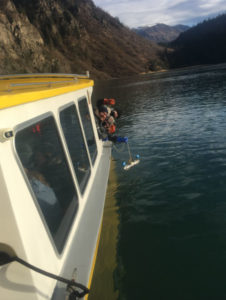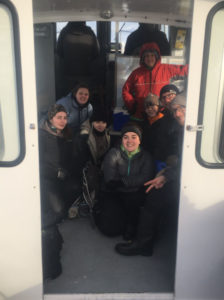Words by Eloise Brown, photos by Brown and several students enrolled in class
Who says you have to go to Hawaii during winter to visit the ocean? Earlier this semester, students taking an Oceanography course at Alaska Pacific University taught by Eloise Brown went on a field trip to Kachemak Bay to get some hands-on experience collecting oceanographic data in Alaska. They were joined by Arianna Lawes-Wiseman, another student working on Harmful Algal Blooms (HABs) for her APU Senior Research Project.
It was a long drive in the van to Homer. The spectacular sunrise made the early start and the cold wind over the bay worth it! During a half-day oceanographic cruise through the Center for Alaskan Coastal Studies, students performed plankton tows, took depth profiles of salinity and temperature, and measured the depth of light attenuation with a Secchi disk. The group was looking for evidence of stratification, which can create conditions favorable for HABs. A slight gradient in salinity was observed, with fresher waters at the head of China Poot Bay and in the surface waters due to runoff from streams and rivers. Later, using microscopes at the Islands and Ocean Visitor Center in Homer, students identified common species of phytoplankton and zooplankton collected in their plankton tows.
The next morning, students awoke to fresh snow outside their yurts at the Ageya Wilderness Education in Homer, before jumping back into the van for the trip home. Back at APU, students summarized the data they had collected and presented their results to the class. They discovered that a Coscinodiscus (ACCS 2016) diatom bloom was present in the surface waters of Kachemak Bay.
“The algal bloom was fascinating. It was amazing to see how much life exists outside of our daily awareness,” said student Erin Bergen.
Coscinodiscus sp. is a genus of diatoms common off the west coast (Kudela et al. 2007). At one station, the diatom bloom was so thick that the Secchi disk was no longer visible less than 2 m below the ocean surface, compared to 4-5 m at the other stations.
“I had a great time and was stoked to learn some field skills that I will actually use in my career,” student Ben Wilkins said of the experience. Student Emily Smith added, “Its always wonderful when a course takes you out to explore the beauty of Alaska’s seas and gives you real-world experience working in the field.”
APU would like to acknowledge the team led by Kris Holderied from the National Oceanographic and Atmospheric Administration Kasitsna Bay Laboratory including Dominic Hondolero, Kim Powell, and Mike Geagel for sharing data and for the use of their oceanographic equipment, and Seth Spencer with the Center for Alaskan Coastal Studies for organizing this amazing experience.






